Archives help preserve the past. Modern archives are dependent on technology. What happens when the technology used to store the past becomes obsolete? Will this information be lost forever at the next update? Words by David Mizzi.
Do you remember that old school project you had saved on a floppy disk? Using something like a floppy disk to store information is great, but only if you have a floppy disk reader. Finding one today is a tall order; that school project could be lost to time.
Future generations will be able to see our culture only if they have the right technological tools. Our ‘modern’ hard drives will eventually go the way of the dodo (or floppy, in this case), resulting in a digital dark age.
Digital isn’t as permanent as we think. Digital formats can become corrupted, degraded by bit rot, or obsolete. Future generations may find it difficult or impossible to retrieve electronic documents and multimedia because they don’t have the technology to retrieve it any more.
But what if there were a way to permanently preserve works of art, without the risk of technology making them obsolete?
Preserved in Plastic
Julia Galea, an MA graduate from the department of Digital Arts at the University of Malta, has an idea to ‘future-proof’ an artwork with the technology available today. Most current recorded formats depend on some kind of playback equipment (floppy disks require floppy drives; SD cards require appropriate readers). These tend to become obsolete very quickly. We cannot assume that future generations will have the means to process and understand our archives.
Galea’s research has found a way to turn the imperishability of plastic into a time capsule. The ingenuity of her research is bringing an art object, such as an image, into the physical space. Enter the plastic slides.
These 3D-printed reliefs fit in the palm of your hand and depict the recorded artwork when held up to the light. Through 3D printing, these slides effectively create mechanical reproductions of digital artworks and, as a happy side effect, produce a physical archive.
While materials such as magnetic tape already exist and are able to record and reproduce a wide range of formats, they need equipment to recover. As Julia puts it, ‘assuming the sun stays in the sky, the plastic slides should always be capable of reproducing the image.’
Plastic’s long lifespan has led to widespread environmental degradation, but it’s that same property that Galea uses. Plastic slides are practically imperishable. ‘The idea of creating these plastic slides was to use a material that theoretically could outlive any current material utilised for recording images.’

To develop these slides, Galea used three-dimensional rendering, printing, scanning, and computer-automated translation of data. The body of work created throughout this research was constructed and developed on 3D rendering software and various 3D printers. Through a semi-automated process, the 3D rendering software analysed a flat image by pinpointing a tonal value range and printing out the image (in relief) as a plastic slide.
Galea’s research was first met with skepticism, being seen as creating a solution to a problem that will never exist. Technology is quickly being superseded, and many digital artworks have already been lost. Unless current archives keep up, a lot more art and history will be lost.
The Archive of the Future
Dr Clive Zammit (Faculty of Media & Knowledge Sciences, University of Malta), Galea’s supervisor, points out that, ‘The more technologically advanced we are, the more vulnerable to obsolescence we become’. He refers to philosopher Jacques Derrida, who points out the inherent tension within the archive. On the one hand, it is a means of preserving the past, yet it needs to continuously advance for archives to remain relevant.

Technology also embodies this tension. It allows for a greater quantity of ideas and data to be stored as the technology advances. But it also leaves a trail of loss, as earlier mediums become obsolete.
The use of plastic opens up issues around the sustainability behind art, museums, and archives. All of these aspects need to consider sustainability to be future-proof. Besides the practical and artistic applications behind these plastic slides, they also invite us to reconsider sustainability by viewing plastic as a solution to a problem.
Future archives might have entire wings dedicated to hand-held slides, each one carefully catalogued and made from recycled plastic without the need for any sophisticated equipment to read. These slides could easily survive any technological disaster. The very act of holding something against the light is intuitive.
Not to mention the beautiful irony behind using the very thing that is destroying the future to preserve the past. Perhaps plastic might preserve art (and your old school project!) for future generations.






Comments are closed for this article!